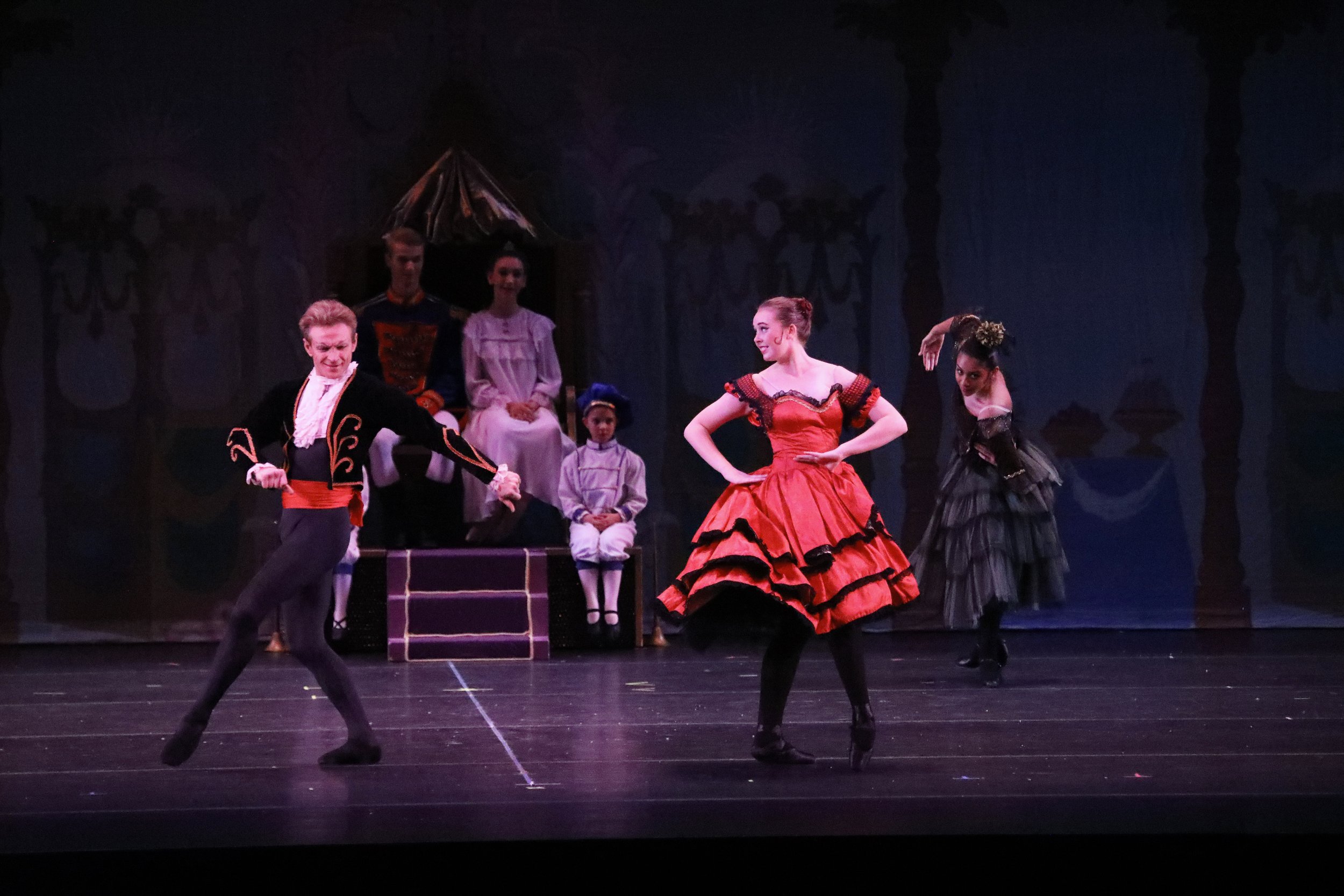
Don Quixote - Ballet 6
Don Quixote has been adapted for ballet many times, the earliest in 1740 by choreographer Franz Hilverding in Vienna, Austria. This version was later revived and adapted in 1768 by Jean Georges Noverre to the music of Josef Starzer. Charles Didelot, known today as the "father of Russian Ballet," choreographed a two-act version in St. Petersburg for the Imperial Ballet in 1808. In 1809 a version of Didelot’s work was mounted at Her Majesty's Theatre by James Harvey D'Egville. Paul Taglioni presented his own version for the Berlin Court Opera Ballet in 1839, and his uncle, Salvatore Taglioni, set a production at the Teatro Regio, in Turin, in 1843. The most famous and successful version was choreographed by Marius Petipa of the Imperial Ballet in 1869. Most modern productions are derived from the revival of Petipa’s production staged by Alexander Gorsky for the Bolshoi Theatre in 1900. Gorsky’s adaptation was not met with the same popularity as Petipa’s, yet it has endured and is the most widely performed adaptation today.
The music was composed by Ludwig Minkus in 1869.
While originally 3 acts, Petipa and Minkus created an expanded and elaborated edition of the ballet in five acts and eleven scenes for the Imperial Ballet in 1871.
In the Prologue of the ballet, Don Quixote de la Mancha delights in stories of brave knights, fabulous giants and other fantastical creatures, but most of all he dreams of his beloved Dulcinea, a woman that he believes to be so lovely and noble that she must be divinity. Driven by the vision of Dulcinea, Don Quixote begins his adventures with his trusty squire Sancho Panza in tow. Act 1 begins in the market-place of Barcelona. Kitri, Lorenzo’s daughter, is in love with Basilio, but her father plans to marry her to the nobleman, Gamache. Don Quixote and Sancho notice Kitri, and Don Quixote wonders if he has, at last, found his Dulcinea. Kitri, Basilio, and their friends sneak off. They are pursued by Don Quixote, Sancho, Gamache and Lorenzo. In Act 2 Don Quixote and Sancho discover the fleeing couple in a friendly gypsy camp. After some performance, Don Quixote sees the moon, and think it is his Dulcinea. He foolishly attacks a windmill, believing it to be a giant threatening Dulcinea’s safety. Failing miserably, he collapses into a deep sleep, and has even more fantastical visions of beautiful maidens and his Dulcinea. Lorenzo and Gamache interrupt Don Quixote’s dream. Don Quixote now realizes Kitri is not his “ideal”, but indeed belongs with Basilio. Sympathetic to the plight of the young lovers, Don Quixote attempts to lead Lorenzo and Gamache astray. When Kitri and Basilio are discovered, Lorenzo gives his blessing to her union with Gamache. Basilio reproaches Kitri for her unfaithfulness, draws a sword and stabs himself. As he lies dying he begs Lorenzo to unite him with Kitri, but Lorenzo and Gamache refuse. Don Quixote approaches Gamache and challenges him to a duel for having refused a dying man's wish. Gamache declines to fight and the merrymakers drive him out of the inn. Taking pity, Lorenzo agrees to unite Basilio and Kitri. At this moment, Basilio pulls out the sword and tells everyone it was a joke. Act 3 is comprised of Kitri and Basilio’s wedding. Don Quixote congratulates the couple, bids them a warm “farewell”, and resumes his ever-lasting adventures.
The pictures above are actually of the Chocolate or Spanish divertissement from The Nutcracker in 2018, but the red dress looks like it was made for Kitri. It was made by volunteer back when MFB was Ballet Midland! Photos by P W Dance Photography.
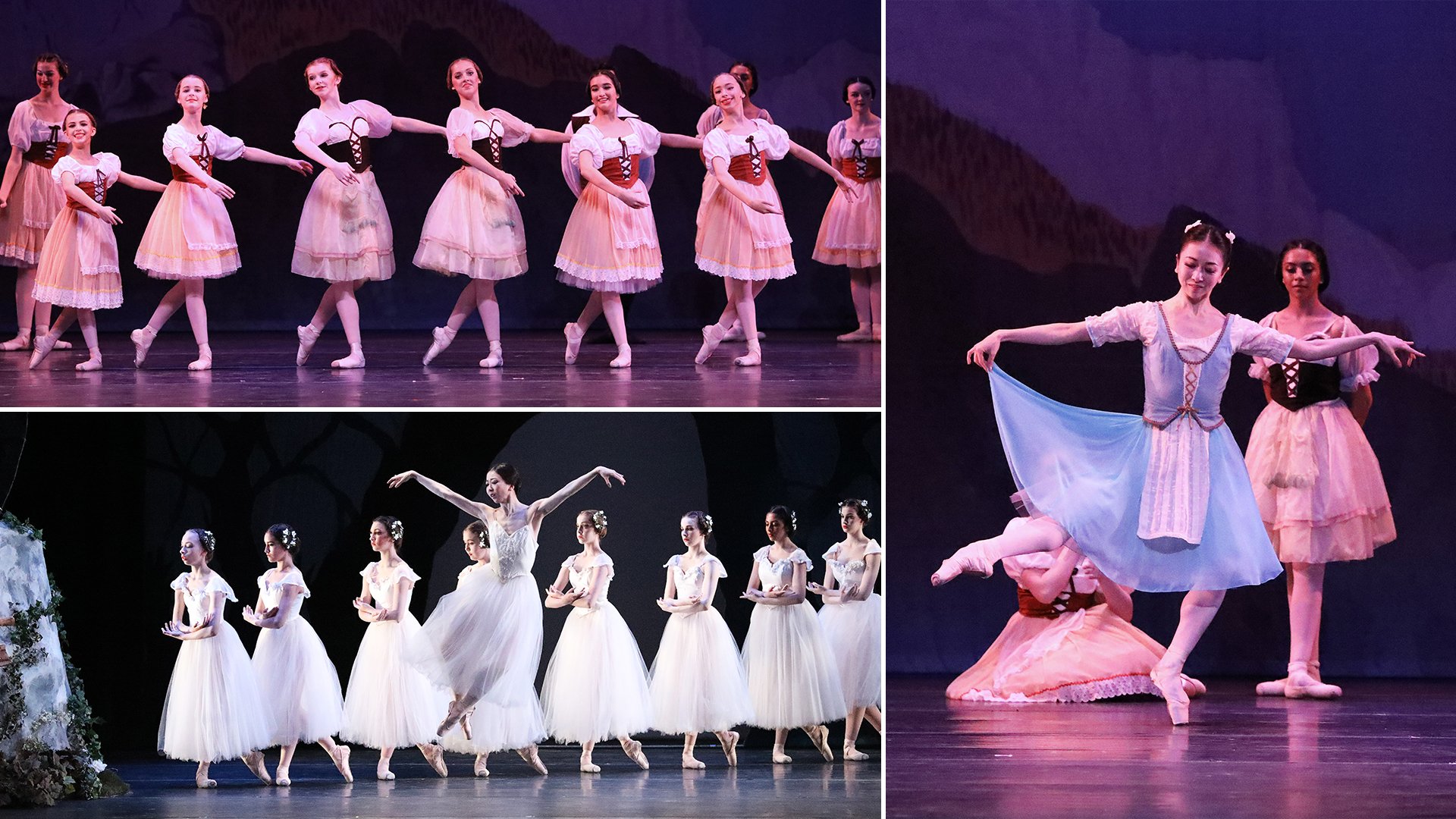
Giselle - Ballet 4
The music was composed by Adolphe Adam in 1841.
Jules Perrot of the Paris Opera and Imperial Ballet created the original choreography with the help of Jean Coralli. Most modern-day productions use choreography derived from the revivals staged by Marius Petipa of the Imperial Ballet.
The ghost-filled ballet tells the tragic, romantic story of a beautiful but fragile young peasant girl who falls for the flirtations of the disguised nobleman Albrecht. When the ruse is revealed, Giselle dies of heartbreak, and Albrecht must face the otherworldly consequences of his careless seduction. The second act is largely dominated by the Wilis, the spirits of maidens who died after being betrayed by their lovers, and take revenge in the night by dancing men to death by exhaustion (a popular theme in Romantic-era ballets). Led by Myrtha, the Queen of the Wilis, they summon Giselle from her grave and target Albrecht, but Giselle's love frees him from their grasp. By saving Albrecht from the Wilis, Giselle also saves herself from becoming one of them.
The photos above are from MFB’s 2019 production. Photos by P. W. Dance Photography.
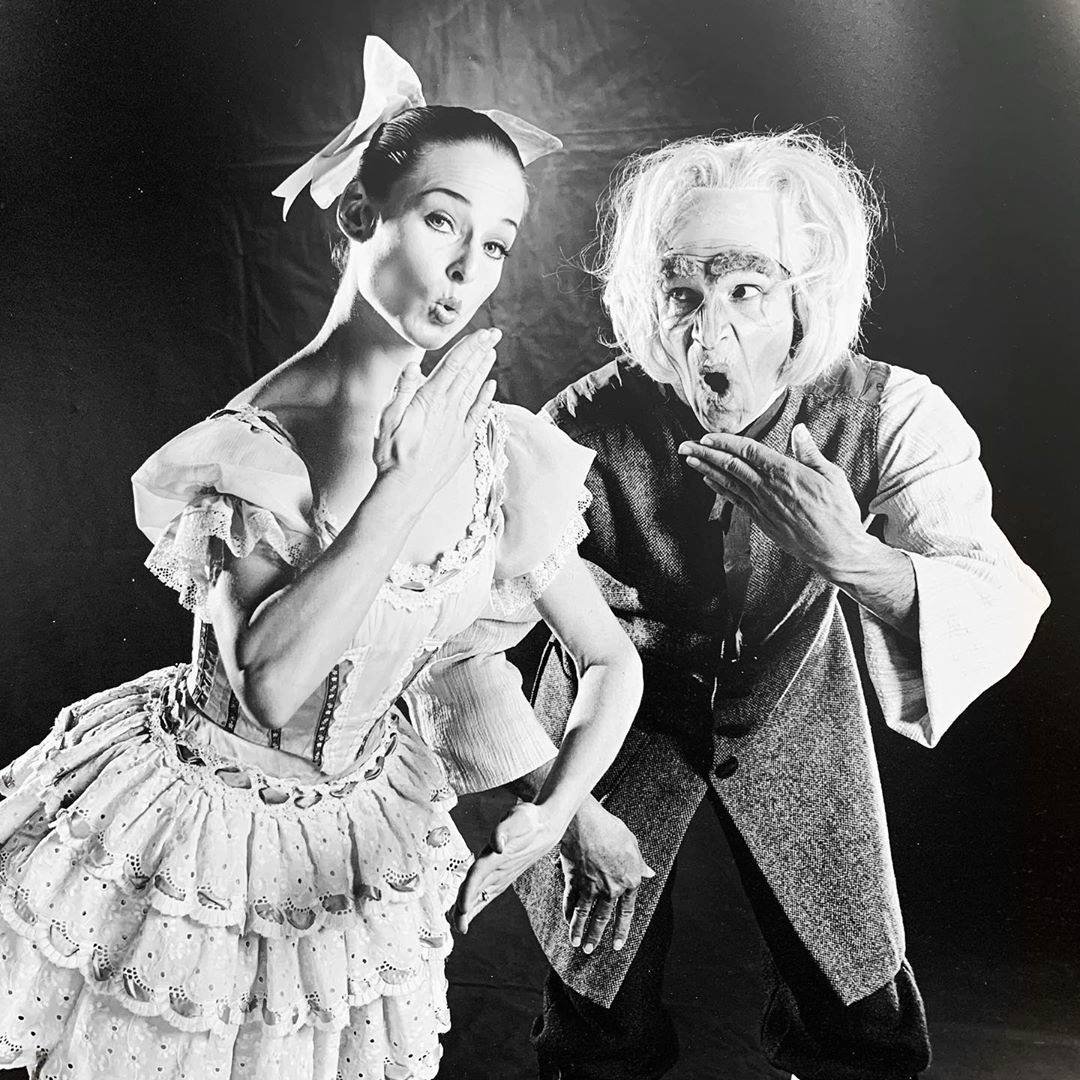
Coppelia - Ballet 3
Do you recognize our Artistic Director, Susan Clark?! This photo is from Milwaukee Ballet’s 1992 production.
Coppelia is Greek for young woman.
Choreography for the original production was by Arthur Saint-Léon, Ballet Master of the Paris Opera and Imperial Ballet. He died 2 days after the ballet’s premiere season in Paris. Modern-day productions are traditionally derived from the revivals staged by Marius Petipa of the Imperial Ballet.
Saint-Léon is also known for inventing a method of ballet notation for which to record ballets. This would make it possible for the original steps to be preserved and passed on to other companies without the original choreographer or cast. Remember, this is before you could make a video recording.
The music was composed by Léo Delibes of the Paris Opera in 1870.
Coppelia was an immediate success, and quickly became the most performed ballet of the Paris Opera.
The ballet is about a doctor, Dr. Coppelius who has made a life-size doll. It is so lifelike that Franz, a village youth, becomes infatuated with it, upsetting his betrothed, Swanhilda. Wanting to learn more about the mysterious woman who has stolen the heart of her beloved, Swanhilda and her friends sneak into the doctors house and discover the truth. Dr. Coppelius comes home and kicks out Swanhilda’s friends, but Swanhilda hides with the doll behind a curtain. Meanwhile, Franz has come to the house to meet the mysterious woman. Dr. Coppelius invites him in, for he wants to bring his doll to life with a magic spell, but he needs a human sacrifice. So the Doctor gives Franz some wine laced with sleeping powder, and once asleep, tries to transfer Franz’s spirit to his beloved doll. It is not the doll, but Swanhilda in the doll’s clothes that begins to move and dance around, which makes the doctor think he has been successful! Swanhilda wakes Franz and winds up all the mechanical dolls to aid their escape. Dr. Coppelius becomes confused and then saddened when he finds the lifeless doll behind the curtain. Swanhilda and Franz make amends, and are married at the festival surrounded by friends.
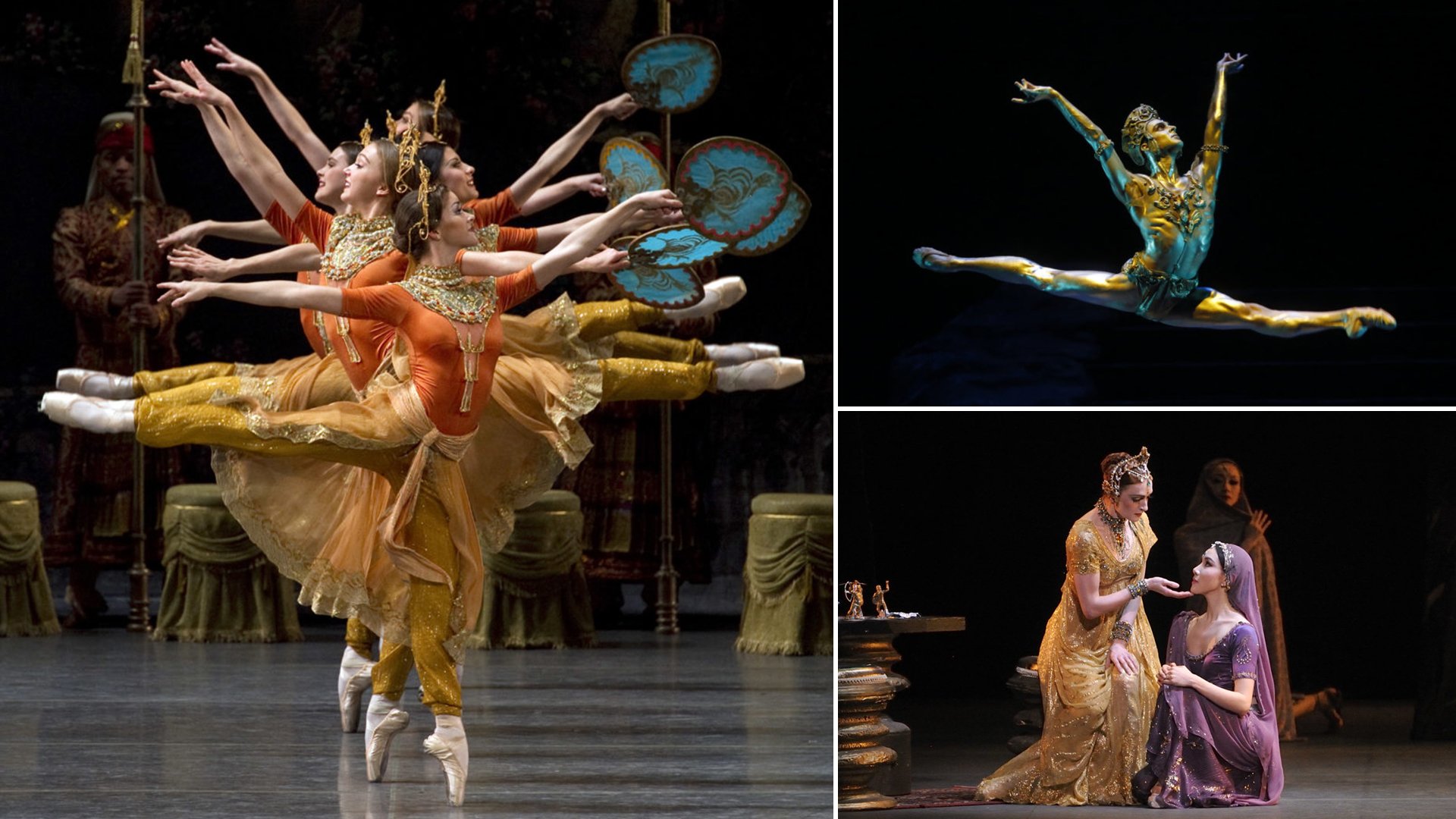
La Bayadere - Ballet 2
The word bayadere is French for Indian temple dancer, originating from the Portuguese word ballar, meaning dance.
The ballet was originally choreographed to be 4 acts by Marius Petipa of the Imperial Ballet in 1877. It was immediately hailed as one of Petipas’ supreme masterpieces. Nearly all modern versions of La Bayadère are derived from the severely redacted edition of the Kirov Ballet which was staged by Vakhtang Chabukiani and Vladimir Ponomarev in Leningrad in 1941.
Music was originally composed by Ludwig Minkus in 1877.
Set in the Royal India of the past, La Bayadere is a story of eternal love, mystery, fate, vengeance, and justice. In Act I, the High Brahmin, priests, and temple dancers are celebrating the Indian Ritual of Fire. Nikiya, the most beautiful of the bayadères, has been chosen to be consecrated the lead temple dancer. The High Brahmin declares his love for Nikiya, but is rejected by her. Nikiya meets secretly with Solor, a noble warrior later that evening. They dance together and swear eternal love over the Sacred Fire, but are discovered by the jealous High Brahmin, who vows to kill Solor. In the next scene, the Rajah has decided to reward Solor’s valor and decrees that the warrior will marry his daughter, Gamzatti. Gamzatti falls in love with Solor’s portrait, and when they meet, he is overwhelmed by her beauty. Even though he has sworn eternal love to Nikiya, he cannot defy the wishes of the Rajah and agrees to marry Gamzatti. The High Brahmin informs the Rajah of Nikiya and Solor’s secret love, hoping that the Rajah will do away with Solor. Instead, the Rajah decides to kill Nikiya. This conversation is overhead by Gamzatti, who summons Nikiya to her rooms and attempts to bribe Nikiya to give up Solor. Refusing, Nikiya frantically attempts to kill Gamzatti. Nikiya flees and Gamzatti swears to destroy her. At the betrothal of Solor and Gamzatti, Nikiya is commanded to dance. Gamzatti presents her with a basket of flowers that Nikiya believes to be from Solor, and which conceals a deadly snake. Nikiya is bitten, and when Solor leaves with Gamzatti, she refuses the antidote and dies. Act II begins with grief‑stricken Solor under the influence of opium dreaming of being reunited with Nikiya in the Kingdom of the Shades. Awakening, he realizes that he must prepare to marry Gamzatti. In Act III, the vision of Nikiya remains with Solor as the wedding ceremony begins at the Sacred Temple. As Solor and Gamzatti say their vows and are blessed by the High Brahmin, the vengeance of the gods is unleashed, and the temple and all the celebrants are destroyed. Nikiya and Solor are once again united in eternal love.
The above photos are from American Ballet Theatre’s production.
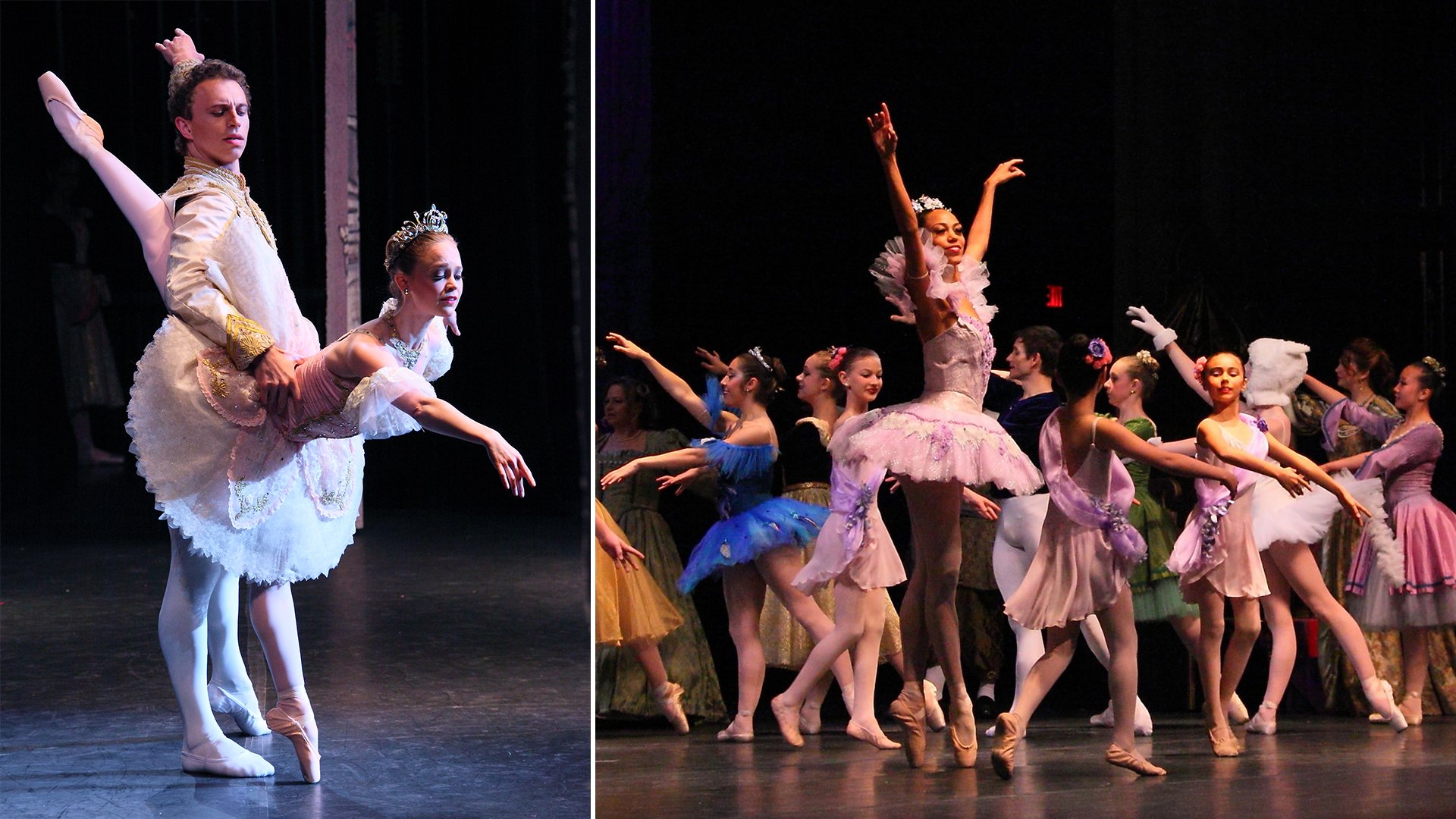
Sleeping Beauty - Pre-Ballet
If you’ve seen Walt Disney’s The Sleeping Beauty, you’ve heard some of the ballet’s score! It was composed by Peter Ilyitch Tchaikovsky in in 1889. It is his longest ballet, lasting nearly four hours at full length (counting the intermissions). The complete score runs practically 3 hours. It is nearly always cut.
The choreographer of the original production was Marius Petipa, Ballet Master of the Imperial Ballet of Russia.
By 1903, The Sleeping Beauty was the second most popular ballet in the repertory of the Imperial Ballet, having been performed 200 times in only 10 years.
The Ballet has seven fairies. Five are credited based on the gifts, or rather attributes they bestow on Aurora: beauty, wit, generosity, liveliness and intelligence. The Lilac Fairy is the main fairy godmother to Aurora. She does not get to bestow her gift before Carabosse, the evil fairy, curses the princess. So the Lilac Fairy uses her power to temper the curse. Instead of Aurora dying after pricking her finger on a spindle when she turns sixteen, she will fall into a deep sleep.
Another key difference is how long the tempered curse lasts. Aurora and her kingdom are asleep for one hundred years before a prince comes to lift the spell.
Act 3 of the ballet is Princess Aurora and Prince Désiré’s wedding. The invited guests include many fairy tale characters— Puss-in-Boots, Red-Riding-Hood, Cinderella, Hop-o’-my-Thumb, Princess Florine and the Bluebird, among others— who present their stories as gifts to the royal couple.
In the spirit of forgiveness and celebration, Carabosse is invited to Princess Aurora and Prince Désiré’s wedding.
The above photos are from the wedding scene of Midland Festival Ballet’s 2 act adaptation of Sleeping Beauty in 2014. Photography by Leave the Camera.
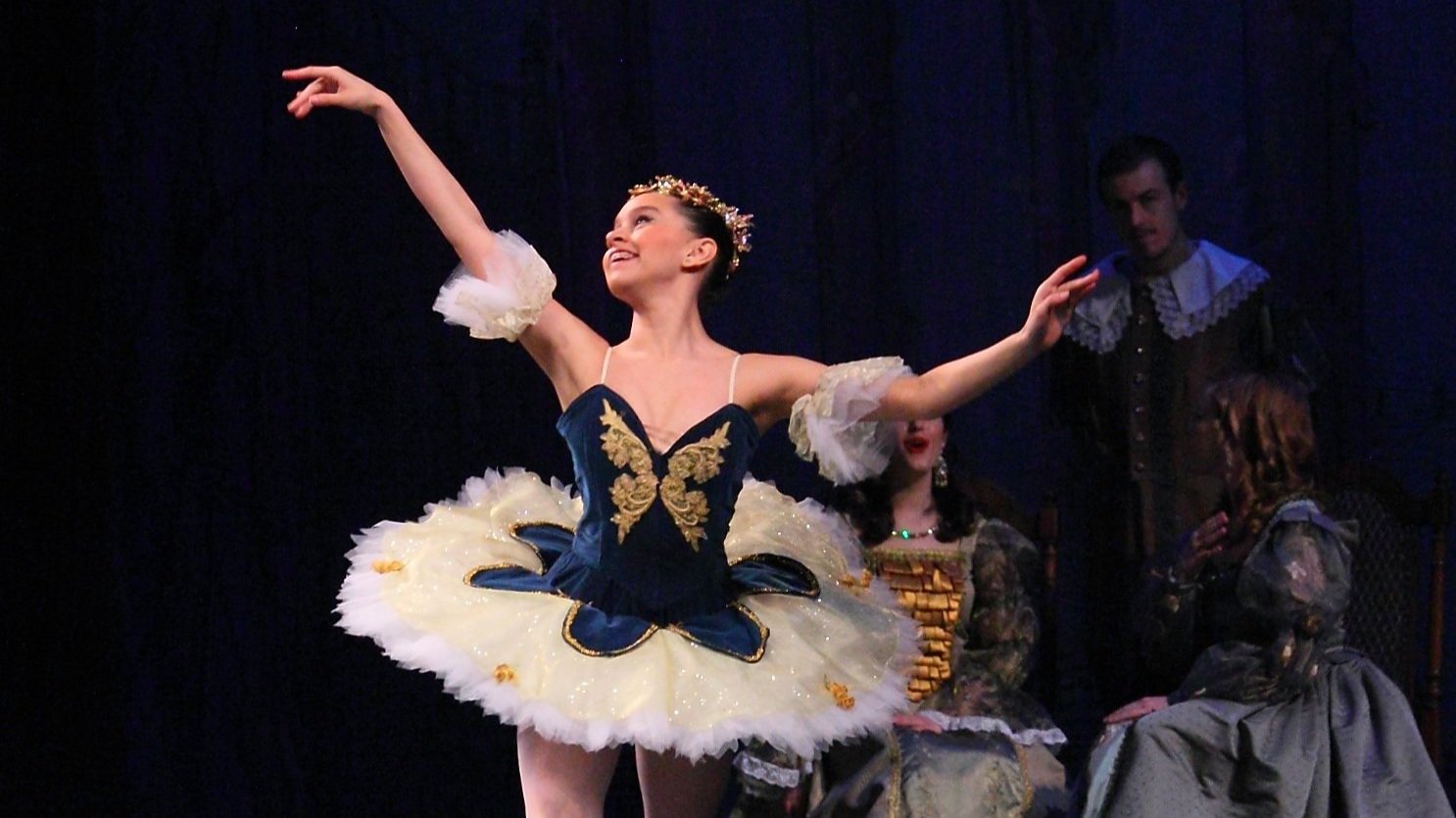
Raymonda - Academy
Originally choreographed by Marius Petipa in 1898 when he was 80 years old.
The music is Opus 57 by Alexander Glazunov.
Set in the 12th century, the beautiful young countess, Raymonda is waiting for the return of her beloved fiancé, Jean de Brienne, the noble knight of the Crusades. But a Saracen knight, Abderakhman and his men arrive and seek shelter for the night. Captivated by Raymonda's beauty, Abderakhman falls in love with her at once and resolves to do anything to win her. The party lasts late into the night and, left alone and exhausted, Raymonda lies down and falls asleep. As she sleeps, she begins to dream and the White Lady appears, beckoning Raymonda to follow her. She dreams that she is reunited with Jean de Brienne! Raymonda expresses her joy to the White Lady, who interrupts her enthusiasm with a vision of what awaits her. Raymonda wants to return to her fiancé, but instead, she finds Abderakhman. He declares his passionate love for her, but Raymonda, though confused and upset, is quick to reject him. Abderakhman tries to take Raymonda by force. Raymonda cries out and falls to the ground in a faint. The frightful vision disappears along with the White Lady. In Act 2, the feast in honour of Jean de Brienne's arrival is taking place. Raymonda welcomes her guests, but cannot hide her uneasiness caused by Jean de Brienne’s delay. Abderakhman approaches her repeatedly and reveals his passion for her, but remembering the warnings of the White Lady, Raymonda rejects him with contempt. Abderakhman realises the only way to possess Raymonda is by force, so he calls his slaves to distract the guests while some pour a potion into everyone’s cup, causing all the guests to become drunk. Seizing his chance, Abderakhman grabs Raymonda in an attempt to abduct her, but luckily Jean de Brienne arrives just in time. Jean de Brienne kills Abderakhman in a duel, and Raymonda is joyfully reunited with her fiance. Act 3 portrays their wedding celebration.
Photo by Leave the Camera.
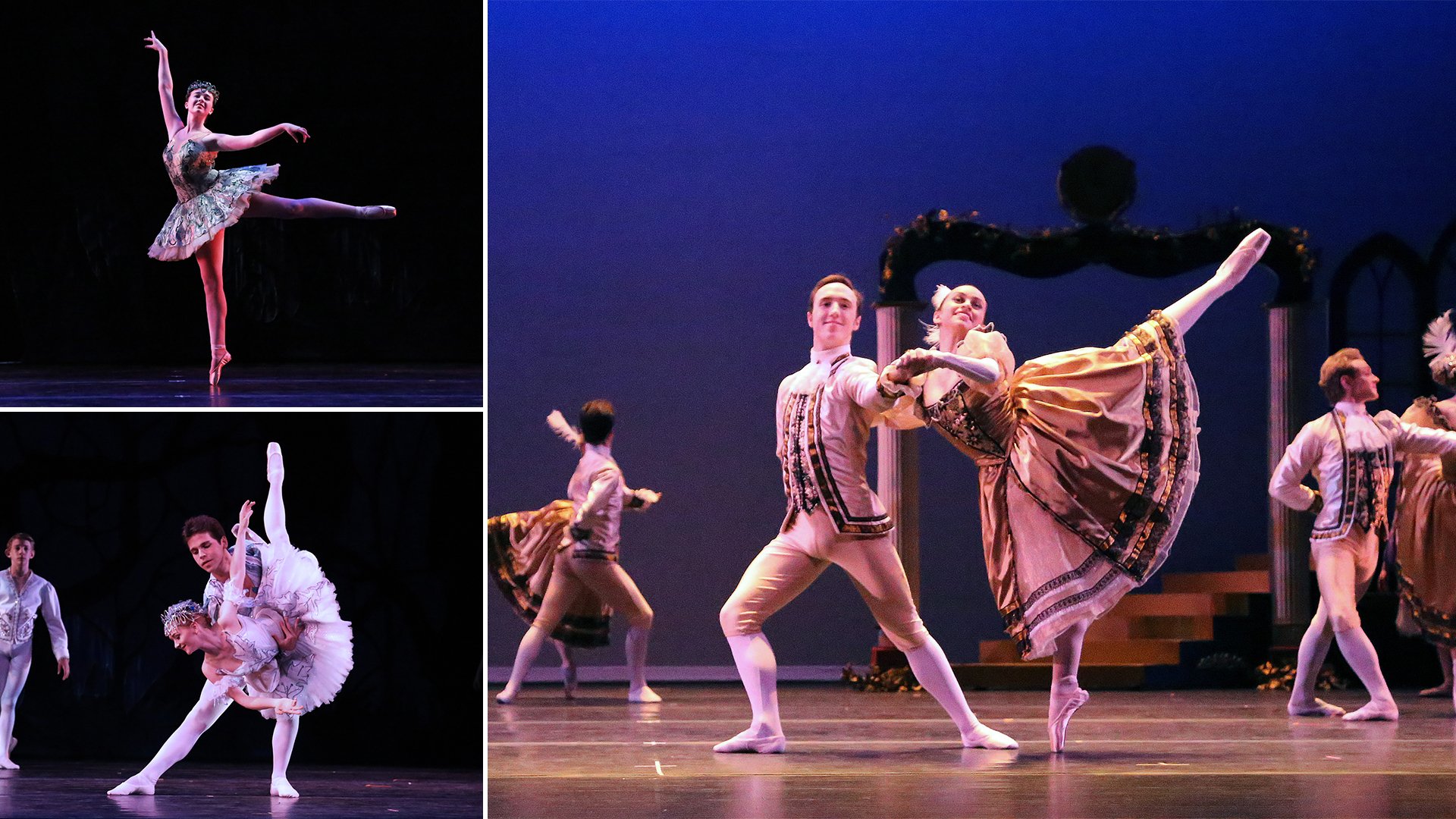
Cinderella - Ballet 1 & Ballet 5
Composed by Sergei Prokofiev between 1940 and 1944.
It was originally choreographed by Rostislav Zakharov, the principal choreographer of the Bolshoi Theatre.
In the original ballet story, Cinderella’s father is still alive. The stepmother bosses him about just as she does Cinderella.
The stepsisters are traditionally performed in travesti - a theatrical term which means performed by a dancer the opposite sex of the character’s. The stepsisters are comedic characters in the production, and being performed by men is intended to make them even more funny.
Along with Cinderella’s Fairy Godmother, there are also the fairies of Spring, Summer, Autumn and Winter. They all help grant Cinderella’s wish to attend the Ball.
The pictures above are from MFB’s 2 act adaptation of Cinderella in 2017. Top left is the Spring Fairy, bottom left is the Winter Fairy, and the right are two guests of the Ball. These three pieces of music, along with Cinderella’s variation will be used during our Showcase! Photos by P. W. Dance Photography.






